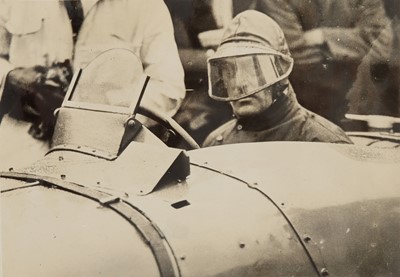30th Apr, 2024 13:00
Photographs & Optical Toys
1930;s Motor Sport Sir Malcolm Campbell
Period photograph of Sir Malcolm Cambell sitting in a racecar, 1930's mounted on period album leaf, image 18cm x 13cm, text below reads der Weltrekordhalter - the world record holder
Sir Malcolm Campbell: A Speed Pioneer
Major Sir Malcolm Campbell MBE, will be forever remembered for his daring exploits on land and water. Born on March 11, 1885, Campbell's legacy extends far beyond his lifetime, shaping the very fabric of speed records and inspiring generations of enthusiasts worldwide.
Famously associated with the iconic Blue Bird vehicles, Campbell's quest for speed was relentless. His achievements were not only personal triumphs but also a testament to the spirit of human ingenuity and perseverance.
In 1924, Campbell etched his name in the record books by breaking the land speed record for the first time. Roaring across Pendine Sands near Carmarthen Bay in a 350HP V12 Sunbeam, he reached an astonishing 146.16 mph (235.22 km/h). Today, the very car he piloted proudly sits on display at the National Motor Museum in Beaulieu, a testament to his pioneering spirit.
But Campbell's thirst for speed was insatiable. Between 1924 and 1935, he shattered nine land speed records, leaving a trail of dust and awe in his wake. Three of these triumphs were achieved at Pendine Sands, while five were conquered at Daytona Beach, each victory pushing the boundaries of what was deemed possible.
In 1925, Campbell further solidified his reputation by setting a new lap record of 100 mph (160.93 km/h) at Brooklands, showcasing his versatility and mastery behind the wheel of a streamlined Chrysler Six.
However, it was on February 4, 1927, that Campbell reached the zenith of his career. At Pendine Sands, he obliterated previous records, achieving speeds of 174.883 mph (281.447 km/h) in the Napier-Campbell Blue Bird, setting both the Flying Kilometre and Flying Mile records.
Yet, perhaps his crowning achievement came on September 3, 1935, at the Bonneville Salt Flats in Utah. Here, Campbell made history by becoming the first person to drive an automobile over 300 mph, averaging a mind-boggling 301.337 mph (484.955 km/h) in two passes. His feat remains a testament to human courage and technological innovation.
Tragically, Campbell's remarkable journey came to an end in 1948, when he succumbed to a series of strokes in Reigate, Surrey, at the age of 63. His passing marked the end of an era, yet his legacy endures as a beacon of inspiration for generations to come.
Sold for £100
Result including buyers premium
Period photograph of Sir Malcolm Cambell sitting in a racecar, 1930's mounted on period album leaf, image 18cm x 13cm, text below reads der Weltrekordhalter - the world record holder
Sir Malcolm Campbell: A Speed Pioneer
Major Sir Malcolm Campbell MBE, will be forever remembered for his daring exploits on land and water. Born on March 11, 1885, Campbell's legacy extends far beyond his lifetime, shaping the very fabric of speed records and inspiring generations of enthusiasts worldwide.
Famously associated with the iconic Blue Bird vehicles, Campbell's quest for speed was relentless. His achievements were not only personal triumphs but also a testament to the spirit of human ingenuity and perseverance.
In 1924, Campbell etched his name in the record books by breaking the land speed record for the first time. Roaring across Pendine Sands near Carmarthen Bay in a 350HP V12 Sunbeam, he reached an astonishing 146.16 mph (235.22 km/h). Today, the very car he piloted proudly sits on display at the National Motor Museum in Beaulieu, a testament to his pioneering spirit.
But Campbell's thirst for speed was insatiable. Between 1924 and 1935, he shattered nine land speed records, leaving a trail of dust and awe in his wake. Three of these triumphs were achieved at Pendine Sands, while five were conquered at Daytona Beach, each victory pushing the boundaries of what was deemed possible.
In 1925, Campbell further solidified his reputation by setting a new lap record of 100 mph (160.93 km/h) at Brooklands, showcasing his versatility and mastery behind the wheel of a streamlined Chrysler Six.
However, it was on February 4, 1927, that Campbell reached the zenith of his career. At Pendine Sands, he obliterated previous records, achieving speeds of 174.883 mph (281.447 km/h) in the Napier-Campbell Blue Bird, setting both the Flying Kilometre and Flying Mile records.
Yet, perhaps his crowning achievement came on September 3, 1935, at the Bonneville Salt Flats in Utah. Here, Campbell made history by becoming the first person to drive an automobile over 300 mph, averaging a mind-boggling 301.337 mph (484.955 km/h) in two passes. His feat remains a testament to human courage and technological innovation.
Tragically, Campbell's remarkable journey came to an end in 1948, when he succumbed to a series of strokes in Reigate, Surrey, at the age of 63. His passing marked the end of an era, yet his legacy endures as a beacon of inspiration for generations to come.
Auction: Photographs & Optical Toys, 30th Apr, 2024


